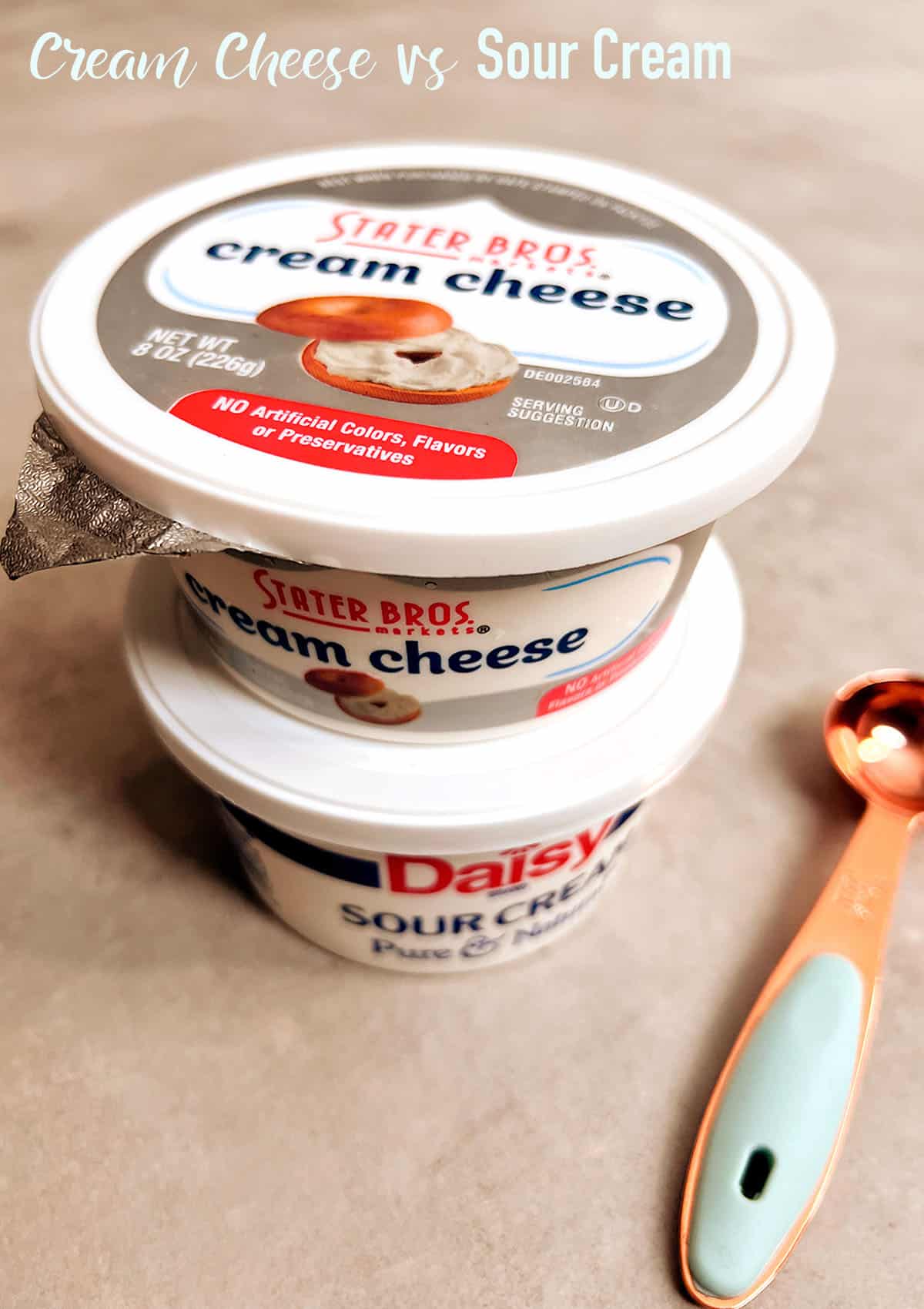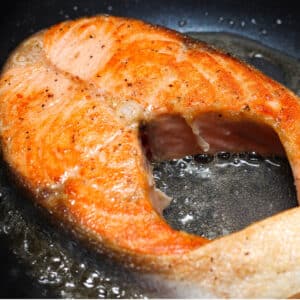Cream cheese and sour cream are popular dairy products in various dishes and recipes. While they may look similar and may even be used in some of the same dishes, they are quite different in terms of their flavor, texture, and nutritional profile. So, what sets these two creamy condiments apart?
Whether you're making a rich and creamy dip, a fluffy frosting, or a tangy salad dressing, understanding the characteristics of cream cheese and sour cream will help you choose the right ingredient for the job. So let's get started!
Cream cheese vs sour cream: Know the Differences
Two popular choices are sour cream and cream cheese for dips, spreads, and toppings. However, these two dairy products are not interchangeable and have their unique characteristics and use.

1 Let's start with the ingredients.
In terms of ingredients, the main difference between sour cream and cream cheese is the type of milk used.
Sour cream is made with cream and fermented milk, while cream cheese is made with cream and milk. Additionally, sour cream is fermented, while cream cheese is not. The fermentation process gives sour cream its tangy flavor and thick, creamy texture, while cream cheese has a milder flavor and a softer, more spreadable texture.
| Sour Cream | Cream Cheese |
|---|---|
| Made from fermented cream and milk | Made from pasteurized milk and cream, with a small amount of bacteria added to create the desired texture and flavor |
| Can contain added thickeners such as gelatin or modified food starch | Can contain added stabilizers such as carob bean gum or carrageenan |
| Can contain added flavorings such as garlic or onion | Can contain added sweeteners such as sugar or honey |
Summary:
The main differences between sour cream and cream cheese are the type of milk used, the fermentation process, and the fat content. Sour cream is made from a mixture of cream and fermented milk and has a tangy flavor and thick, creamy texture, while cream cheese is made from a mixture of cream and milk and has a milder flavor and a softer, more spreadable texture.
2 Texture
One way to understand the difference in texture between these two products is to think about how they behave when they are scooped or spread. Sour cream and cream cheese have a creamy texture, but there are some key differences between the two:
| Property | Sour Cream | Cream Cheese |
|---|---|---|
| Consistency | Thick, creamy | Smooth, spreadable |
| Spreadability | Moderately spreadable | Easily spreadable |
| Firmness | Soft, but holds shape | Soft, holds shape when chilled |
| Meltability | When heated, the fat in sour cream can separate, causing the sour cream to curdle or break down. | it tends to melt more easily when heated. |
Sour cream is made from cream fermented with lactic acid bacteria, giving it its tangy flavor. The consistency of sour cream can range from thick and creamy to slightly runny, depending on the brand and how long it has been fermented. It has a smooth and velvety texture, slightly thicker than heavy cream.
Cream cheese, on the other hand, is made from a mixture of cream and milk, and it has a smooth and spreadable texture similar to the soft cheese. It has a smooth, creamy consistency similar to sour cream but is generally thicker and firmer. It is often used as a spread or a topping for bagels, as well as in a variety of baked goods.
Summary:
The main difference between sour cream and cream cheese in terms of texture is that sour cream is slightly thinner and more fluid, while cream cheese is thicker and more spreadable.
Read:
3 Uses
Sour cream and cream cheese are versatile ingredients used in various dishes. However, they have some differences in how they are typically used in cooking and baking.
| Sour Cream | Cream Cheese |
|---|---|
| Often used as a topping for tacos, baked potatoes, and chili | Often used as a spread for bagels, sandwiches, and crackers |
| Can be used as a thickening agent in soups and sauces | Can be used as a base for dips and spreads |
| Can be used as a substitute for milk or heavy cream in baking | Can be used as a substitute for butter in baking |
| Can be whipped and used as a topping for desserts | Can be whipped and used as a frosting for cakes and cupcakes |
| Can be mixed with mashed avocado to create a creamy spread or dip | Can be mixed with soft fruits such as raspberries or strawberries to create a fruity spread or topping |
- One of the main uses for sour cream is as a topping for a variety of dishes, such as baked potatoes, tacos, and nachos. It is also commonly used as an ingredient in dips, sauces, and dressings. Sour cream is often used to add a tangy flavor and creamy texture to dishes.
- Cream cheese, on the other hand, is often used as a spread for sandwiches and bagels or as a filling for pastries and baked goods. It is also an ingredient in many dishes, such as cream cheese frosting, cheesecake, and dips. Cream cheese is known for its smooth, creamy texture and mild flavor, which make it a popular choice for many recipes.
Summary:
Sour cream is often used as a topping or ingredient in savory dishes, while cream cheese is commonly used as a spread or ingredient in sweet dishes. Both ingredients can be used in various dishes, but they have some differences in their typical uses in cooking and baking.
4 Taste and flavor
Sour cream has a tangy, slightly sour taste due to the lactic acid that is produced when the cream ferments. Cream cheese, however, has a rich, creamy, and smooth taste with a slightly tangy flavor.
The main difference in taste between sour cream and cream cheese is the degree of tanginess. Sour cream is tangier and sourer than cream cheese. This is because sour cream is made by fermenting, which produces lactic acid, giving it its signature tangy flavor. Cream cheese, on the other hand, is made from a combination of cream and milk and is not fermented, resulting in a milder, less tangy flavor.
| Sour Cream | Cream Cheese | |
|---|---|---|
| Taste | Tangy | Creamy |
| Flavor | Mild | Mild |
| Consistency | Thick | Soft |
| Uses | Toppings, dips, baked goods | Spreads, dips, baked goods |
5 Nutrition
Sour cream and cream cheese are dairy products; however, there are some notable differences between the two in terms of their nutrition.
| Sour Cream (source) | Cream Cheese(source) | |
|---|---|---|
| Calories | 200 | 343 |
| Total Fat (g) | 19.5 | 33.5 |
| Saturated Fat (g) | 12.9 | 21.6 |
| Cholesterol (mg) | 67 | 101 |
| Sodium (mg) | 33 | 368 |
| Total Carbohydrates (g) | 6.67 | 4.56 |
| Protein (g) | 3.33 | 5.79 |
One of the main differences is in their fat content. Sour cream is made from fermented cream and typically has a fat content of around 20%. Cream cheese, on the other hand, is made from a combination of cream and milk and has a fat content of around 33%.
Sour cream also has fewer calories per serving compared to cream cheese. A 100g per serving of sour cream has around 200 calories, while the same serving of cream cheese has around 343 calories.
Comparison Table: Cream cheese vs sour cream
| Property | Cream Cheese | Sour Cream |
|---|---|---|
| Definition | A soft, spreadable cheese made from milk and cream. | A thick, tangy dairy product made from fermented cream. |
| Appearance | Smooth, creamy, and spreadable. May come in a brick or tub. | Thick and creamy with a pale yellow color. |
| Texture | Smooth and spreadable | Thick and spoonable |
| Flavor | Mild, tangy, and slightly sweet. | Tangy and slightly sour. |
| Fat Content | High. Typically contains at least 33% milk fat. | High. Typically contains at least 18% milk fat. |
| Production Method | Made by combining milk, cream, and an acidic ingredient (such as vinegar or lemon juice) to form curds. The curds are then drained, pressed, and seasoned. | Made by fermenting cream with bacteria. |
| Uses | Can be used as a spread for sandwiches and bagels, as a base for dips and spreads, or as an ingredient in baked goods and other dishes. | Used as a condiment or as an ingredient in dips, sauces, and baked goods. |
| Nutrition | High in fat and calories. | High in fat and calories. |
| Substitution | Can be substituted with Neufchâtel cheese or a combination of ricotta cheese and heavy cream. | Can be substituted with Greek yogurt or a combination of yogurt and heavy cream. |
| Shelf Life | Typically has a shelf life of 2-3 weeks when unopened and stored in the refrigerator. | Typically has a shelf life of 1-2 weeks when unopened and stored in the refrigerator. |
| Storage | Should be stored in the refrigerator. | Should be stored in the refrigerator. |
| Preparation | Does not require any special preparation. Can be used straight from the package. | Does not require any special preparation. Can be used straight from the container. |
| Versatility in Cooking | Can be used in a wide variety of dishes, including dips, spreads, sandwiches, and baked goods. | Can be used as a condiment or as an ingredient in dips, sauces, and baked goods. |
Read:
Substituting Sour Cream for Cream Cheese
When substituting sour cream for cream cheese in a recipe, I always consider the texture and flavor differences between the two ingredients. Sour cream is much softer than cream cheese, so getting the desired consistency in some recipes can be more challenging. Additionally, sour cream has a slightly tangy taste that may only work with some dishes.
To compensate for these differences, I adjust the quantities of other ingredients in the recipe. This helps ensure that no matter which ingredient I am using, the overall flavor and texture of my dish won't be compromised. Remember, substituting sour cream for cream cheese can work well in some recipes, so consider what the cream cheese plays in the overall recipe and adjust accordingly.
Bottom line:
While sour cream and cream cheese can be used interchangeably in some recipes, it is not a direct substitution as they have different consistencies and flavor profiles. To use sour cream as a substitute for cream cheese, it can be used in equal amounts, but the texture and taste of the final dish may be affected.
Is cream cheese a good substitute for sour cream?
When a recipe calls for sour cream, it's usually much easier to substitute the same amount of cream cheese instead. You'll want to thin out your cream cheese to make the swap. Add about one tablespoon of milk or water per 4 ounces of cream cheese. This will give you a consistency more similar to that of sour cream.
If you'd like, you can also add a splash of lemon juice to replicate the tart flavor that sour cream has. Taste it and add small amounts of water or acid until it meets your desired consistency and flavor. Once you've thinned out your cream cheese, you can use it as a one-to-one substitute for sour cream in any recipe.
Note:
This substitution is particularly effective in cooked and baked recipes, such as casseroles, pancakes, and soups, as the taste and texture of the sour cream usually have little impact on the overall dish. Its recipes are flexible and can accommodate substitutions without significantly altering the final result.




